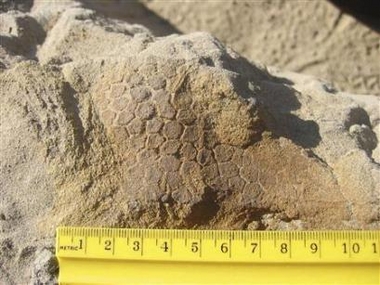Part of the Dinosaur Mummy ready for Display
Dakota the Dinosaur Mummy goes on Display
The arm and tail of a rare mummified dinosaur that has been heralded as one of the most amazing dinosaur discoveries ever made have gone on display in North Dakota’s state museum. The dinosaur, believed to be a type of duck-billed dinosaur called an Edmontosaurus (nick-named Dakota), has been fossilised with a remarkable degree of detailed preservation, including skin and other soft body tissues.
At the unveiling of the first parts of the skeleton to go on display, the audience were able to examine one of the arms and the tail of this huge, plant-eater that roamed Dakota approximately 67 million years ago in the Late Cretaceous (Maastrichtian faunal stage).
The team at Everything Dinosaur first reported on this fantastic fossil in 2007, when the first detailed reports became available: Dinosaur Mummy unlocks Duck-Billed Dinosaur Secrets.
Commenting on the hadrosaurine fossil, Dr Phil Manning, a palaeontologist at Manchester University and one of the international team of researchers working on the project said:
“It is a fascinating fossil, and it’s one which we’re going to be disinterring secrets from … for many years to come”.
When members of the public see the huge reconstructions of dinosaur skeletons within museums, many get the wrong impression, believing that dinosaur fossils must be relatively common. This is simply not true, even fossils of some of the most diverse and numerous types of dinosaur, such as dinosaurs from the Hadrosauridae (the Duck-Billed dinosaurs) are exceptionally rare. Despite having ranged over much of the Northern Hemisphere in the Late Cretaceous only a few hundred hadrosaur fossils are known and the vast majority of these do not represent articulated fossils. Dinosaur bones are extremely rare and to find the mummified remains of a dinosaur is exceptional. Only a handful of mummified dinosaurs have ever been discovered. For young Tyler Lyson, currently completing his Doctorate in Palaeontology at Yale University, who discovered the dinosaur remains on his uncle’s ranch back in 1999, the unveiling permits him to share his amazing discovery with a larger audience. Up until now only the researchers and one or two privileged individuals were allowed to gaze upon this dinosaur, still partially encased in a sandstone block.
This hadrosaur, when it died was buried very quickly by fine sediment and this has preserved parts of the soft body tissue, the dinosaur’s skin scales have even been preserved on parts of the skeleton. How much of the fossil has been recovered has still to be determined as much of the animal is still entombed in a large sandstone block that will take the research teams many years to prepare.
The tail and arm have been extracted from a smaller sandstone block, the larger block, which contains the rest of the fossil has undergone a CAT scan to determine its contents but the stone matrix is very solid and the block so big that the data produced is still being analysed. It is not clear for example whether the skull of the animal has been preserved.
Fossilised Skin of “Dakota” the Edmontosaurus

Picture credit: Xinhua/Reuters
The picture was taken at the dig site and shows the remarkable degree of preservation of the fossilised skin, individual scales can be clearly seen.
“It’s certainly drawing a lot of attention to North Dakota,” commented state palaeontologist John Hoganson, a member of the North Dakota Geological Survey. He went on: “we know people are going to be coming in from all over the country and world to see this”.
It has been estimated that another $100,000 would be required to complete the work of extracting the fossil from its matrix. Already the likes of the National Geographic Society has funded the project to the sum of approximately $200,000 but at this stage a definite cost for the work to be carried out cannot be calculated. Since the scientists are not exactly sure what the sandstone block actually contains, any funding costs at this stage are merely estimates. A spokesperson for the research team who helped remove the arm and the tail estimated that it could take more than a year to reveal the rest of the skeleton.
Everything Dinosaur stocks a rang of hadrosaur figures including replicas of Edmontosaurus: Dinosaur and Prehistoric Animal Models.
It is hoped that when the project has been completed Dakota will go on a world wide tour of museums, probably starting with Japan, before finally going on permanent display in the state after which it was named.
To read more about this fossil: Update on Dakota – the recently discovered Hadrosaurine Mummy.

